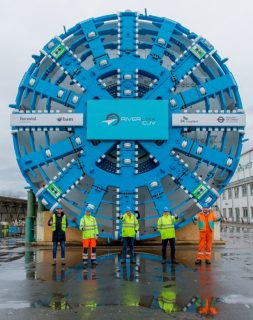Transport for London (TfL) and Riverlinx have announced that tunneling works at Silvertown tunnel have begun. This comes after approximately two years of preparation with approximately 780 individuals working full-time.
The tunneling works will be carried out using an 82-meter-long TBM. The TBM has been given the name Jill in honor of Jill Viner, the first female bus driver in London. However, a small section around the tunnel entrances has been excepted and constructed using the cut and cover method.
The cutting face of the TBM is 11.91 meters long. Thus, it has just been launched and is planned to cross the river at a rate of about 10 meters each day. After the first tunnel is finished, the second tunnel will be finished by turning around and returning to Newham.
Nearly 600,000 tonnes of material will be excavated over the course of the project. Then, it will be transported from the site via barges along the river to a former landfill site in Essex as part of a restoration plan.
The Silvertown Tunnel project introduction
Silvertown Tunnel is a road tunnel being constructed beneath the River Thames across to the Greenwich Peninsula from west Silvertown. Transport for London is the developer while the finance, design, build and maintain tender was awarded to the Riverlinx consortium.
The tunnel will comprise dedicated lanes for heavy cargo vehicles and buses, but it will not be used by cyclists or pedestrians. All future vehicles that will use the tunnel will be zero emission. The Silvertown Tunnel will join the A1020 Silvertown Way from the north side and on the south side with A102 Blackwall Tunnel Approach.
Population and traffic are expected to rise in the area of London because of great developments planned and underway on Greenwich Peninsula, at the Royal Docks, Stratford, and Barking Riverside. The Silvertown Tunnel will provide a better crossing, making sure goods and services still moves swiftly around London.
The scope

The design is for a twin-bore tunnel to link the A1020 Silvertown Way Crossing with the A102 road Blackwall Tunnel Approach, on a sequence similar to the Emirates Air Line cable car. Lane 1 will be committed to cargo vehicles and buses over 7.5t, while lane 2 will be designed for all traffic. The tunnel is going to affect access to Thames Wharf station which was proposed as one of the Docklands Light Railway’s London City Airport extensions.
In 2012, the cost was estimated to be £600m. A consultation in 2015 later revealed that the cost of construction was revised to be £1bn. Maintenance and operation of the tunnel over 25 years are aimed to cost another £1bn. It was proposed that the scheme was to be evaluated in 2006 after the completion of the Thames Gateway Bridge.
Ken Livingstone who was the then London Mayor, supported the project in principle by expressing a preference that the link was to be a road tunnel. The Mayor’s Transport Strategy said that the link construction would accompany the implementation of the subsequently canceled Thames Gateway Bridge.
Read also: The Melbourne Metro Tunnel Project Timeline
Silvertown Tunnel Project Timeline
2012
Silvertown Tunnel and the Gallions Reach Ferry public consultation took place from February to March. The consultation was further conducted from 29 October until 1 February the following year.
2014
A discussion on tolling the Blackwall and Silvertown tunnels opened in October. The government accepted the proposal in 2018 May. November
2019
The contract was awarded to the Riverlinx consortium in November. RiverLinx consortium will design, finance, build and maintain the Silvertown Tunnel.
The consortium consists of Aberdeen Standard Investments, Macquarie Capital, BAM PPP PGGM, Cintra, and SK Engineering & Construction. The twin tunnels and the area surrounding them were also to fall into the Ultra Low Emission Zone from October 2021.
2020
The main construction activity started. It was revealed that most of the construction materials will get transported by river All on-site construction machinery will be meeting the Mayor’s Non-Road Mobile Machinery Low Emission Zone Standards.
All vehicles working on the project will be Euro VI and observe the Mayor’s Direct Vision Standard. The tunnel is intended to lower congestion in the Blackwall Tunnel and the two tunnels will be tolled when it completes in 2025.
Dec 2021
Germany develops a mammoth TBM for the Silvertown Tunnel project

The tunnel boring machine termed the largest to be used in the UK has gone through factory tests and is being shipped for the Silvertown Tunnel project in East London in segments from Germany. The machine’s diameter measures 11.91m – equivalent to around three double-decker buses – overshadowing other former TBMs.
The First segments for the machine have started to arrive on site from the manufacturer Herrenknecht’s works keeping the assembling process on track for the TBM launch next Spring.
The potential to turn the TBM around
The TBM will set off for the Silvertown Tunnel project the launch chamber, piling for which is currently complete and is being excavated. The machine will later be rotated and relaunched from the Greenwich Peninsula, to dig the second tunnel, completing a total length of 2.2km.
The potential to turn the TBM around is a key feature of its bespoke design which incorporates the necessity to navigate forward through the stiff clay layers and boulders in the Greenwich Peninsula. During its work, it will have excavated materials of around 600,000 tonnes, extracted by barges along the river to keep construction traffic to a minimum while the construction is ongoing.
The Riverlinx CJV Project Director, Juan Jose Bregel stated: “It gives the delivery team and I a great sense of pride to have set foot on this significant milestone for the Silvertown Tunnel project. Not only seeing the project really taking shape in readiness for launch at the two major sites at Silvertown and Greenwich but feeling the exhilaration of what is still to come as the pieces of the TBM arrive to be reassembled and launched earlier in 2022.”
January 2022
Keltbra to offer key environmental solutions on the Silvertown Tunnel
A leading UK specialist in the engineering business, Keltbra, has won the contract to offer key environmental solutions for the Silvertown Tunnel. The contract is on behalf of Riverlinx CJV (Ferrovial Construction, BAM Nuttall & SK Ecoplant) and Transport for London (TfL).
Works will comprise the transportation of excavated material through barges able to carry up to 1800 tonnes. Compared with traditional transportation ways, a barge uses 35% less carbon.
The scope of key environmental solutions on the Silvertown Tunnel Keltbray will provide.
- All labor, plant, materials, facilities, equipment, services, supervision, and any resource needed to carry out and finalize the analysis and classification testing.
- Offer barges able to carry up to 1800 tonnes to collect excavated material from the work sites and move to restoration areas for recovery.
- Stockpile management with treatment and/or mixing of the material.
- Transport, off-load and dispose of all waste from the construction.
Keltbray is distinctive in that it can welcome many schemes in London through the River Thames, utilizing the barges use and offering clients many sustainable options for congested London roadways. The firm has the knowledge and expertise to control heavily contaminated soils if found by using its experienced staff and its professional in-house chemists.
After the treatment procedures applied to construction materials which may entail either physio-chemical or mechanical processes, the material is eventually used to benefit restoration areas along the River Thames.
On key environmental solutions on the Silvertown Tunnel, the firm set the goal of implementing the waste hierarchy by attaining 90% (or greater) recycling or reuse of building and demolition waste, and 95% (or greater) recycling or reuse of clean dug material.

